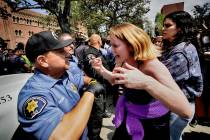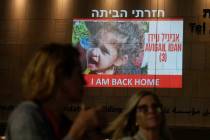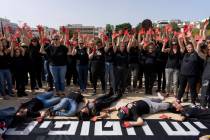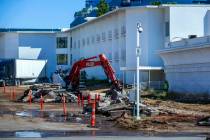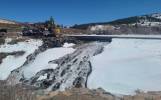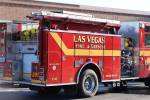Firefighters get break
SAN DIEGO -- A merciful easing of the winds fueling Southern California's wildfires gave firefighters a chance to fight back against some blazes Wednesday, and weary residents could take solace in an overriding sign of hope that just one person had died from the flames.
That contrasts to 22 dead from a fire of similar magnitude four years ago. While the final toll has yet to be tallied from this week's fires, officials were crediting an automated reverse-911 calling system that prompted the orderly evacuation of more than half a million people. That was 10 times the number evacuated four years ago.
"They are more determined that people leave," said Steve Levstik, who got his call 15 minutes before flames swept through his Rancho Bernardo neighborhood.
"It was very intense. On the call, it was like, 'This area, go! This area, go!' In 2003, there was less guidance. It was like, 'Just pay attention to the news, and if it looks bad, leave.' "
On Wednesday, winds dropped to 21 to 36 mph, nothing like the gusts of up to 100 mph that raked fire zones earlier in the week. That helped firefighters fully contain the three major fires in Los Angeles County by nightfall and largely contain many of the fires north of San Diego.
As the fire threats diminished, authorities began allowing tens of thousands of people to return to their homes.
"The vast majority of the city is now open for people to return," San Diego Mayor Jerry Sanders said late Wednesday afternoon.
San Diego County Sheriff Bill Kolender said the priority now is getting people back into their homes and back to their businesses.
The improving weather also allowed for a greater aerial assault on the flames and helped firefighters beat back the most destructive blazes. Within hours of returning to the sky, helicopters and air tankers dropped 30 to 35 loads of water on two fires that have burned hundreds of homes in the San Bernardino Mountains, near Lake Arrowhead.
"They're taking it down considerably," said Dennis Bouslaugh of the U.S. Forest Service.
The death toll from the most recent blazes may rise as authorities return to neighborhoods where homes turned to piles of ash, but displaced homeowners and authorities were relieved that early reports were so low.
The San Diego County medical examiner officially listed six deaths connected to the blazes, but he included five who died during the evacuation who were not directly killed by the fire. In 2003, all but a handful of the 22 dead succumbed to the flames.
Terry Dooley, who was ordered out of his home with his wife and three sons Monday, said authorities learned important lessons from Hurricane Katrina and the 2003 California fires that wiped out 3,640 homes and blackened 750,000 acres during a two-week period.
"They learned how to get things done more quickly," Dooley said as he waited at a roadblock Wednesday to return home to San Diego's upscale, densely populated Rancho Bernardo area.
In addition to the reverse-911 system, authorities also shut down schools, halted mail delivery and urged people to stay home if they were not in danger.
In 2003, only 50,000 people were evacuated in San Diego County. This week, more than 500,000 people were ordered to evacuate in San Diego County.
Another factor separating this year's fires from other disasters has been wealth. Unlike many of the poor neighborhoods flooded by Hurricane Katrina, the hardest-hit California areas were filled with upscale homes, with easy access to wide streets. Less wealthy areas, including rural enclaves and horse farms that stretch through the mountains east of San Diego, benefited from easy road access and small crowds.
Despite Wednesday's progress, none of the six major blazes in San Diego County was more than 40 percent contained. Those fires threatened more than 8,500 houses. The top priority was a fire in San Bernardino County that threatened 6,000 homes and continued to rage out of control.
Overall, 28,000 homes remained threatened across the region, the state Office of Emergency Services said Wednesday night.
This week's fires have destroyed about 1,500 homes since they started late Saturday and triggered the largest evacuation in California history. The flames have burned about 717 square miles, across five counties, from Ventura in the north all the way into Mexico.
Property damage has reached at least $1 billion in San Diego County, and President Bush signed a disaster declaration for California.
Bush was scheduled to visit the region today.
Cooler weather also helped ease the drain on power resources, reducing the threat of rolling blackouts. The California Independent System Operator said San Diego's major east-west electric transmission line returned to service Wednesday after being knocked out by fire. The power supply got a boost from the Navy, which took the unusual step of shifting ships in its sprawling San Diego port from shore power to onboard generators.
That reduced demand on the power grid by almost 100 megawatts, enough to power 100,000 average homes, Navy Capt. Matthew Brown said.
On Wednesday, about two dozen people gathered at a police barricade in Rancho Bernardo, one of the hardest-hit areas, hoping to retrieve medications and belongings or simply to see if their homes were intact.
What awaited many were entire streets leveled, charred hulks of metal that once were cars sitting in driveways of homes with only chimneys left standing. House after house, 29 on one street, were reduced to piles of blackened concrete and twisted metal.
At one point, police officers lifted a barricade into the neighborhood only to turn residents away several hundred yards down the road at a second barricade.
Dooley knew his home was OK because his answering machine still worked.
Six of San Diego County's 42 evacuation centers were full Wednesday, but there was plenty of space at Qualcomm Stadium, home to the NFL Chargers, where 10,000 people sought refuge.
Some displaced homeowners complained that the evacuations went too far.
Ron Morris, 68, saw smoke but no flames Sunday night when he was ordered to leave a motor home park in Ramona, northeast of San Diego. He drove his home to Qualcomm Stadium's parking lot.
"It's good that everyone got out, but they did it too early in my opinion." Morris said.
The only confirmed death from the flames was that of Thomas Varshock, 52, of Tecate, a town on the U.S. side of the border southeast of San Diego, the San Diego County Medical Examiner's Office said. Authorities had told him to evacuate, but he didn't leave, and authorities left to take care of other evacuations, the medical examiner's office said.
Firefighters returned to save two people trapped at his home Sunday but were unable to rescue Varshock, said Rick Hutchinson of the California Department of Forestry and Fire Protection.
Four firefighters were overcome by flames. One was in critical condition Wednesday, and another was in serious condition.
Al Guerin, a San Diego County assistant sheriff, estimated that only 100 to 200 people ignored evacuation orders. That included 20 people in the rural community of Jamul, near the Mexican border. Firefighters returned to save them.
SAN DIEGO COUNTY 30.3% -- Population under age 21 11.1% -- Population age 65 plus $572,000 -- Median home price $69,099 -- Median family income 8.1% -- Families living in poverty 6% -- Households without a vehicle MONEY TO UNINSURED President Bush stepped up federal engagement in the California wildfire emergency Wednesday, signing a major disaster declaration that funnels money to people whose property losses aren't covered by insurance. OTHER PURPOSES Such declarations set in motion long-term federal recovery programs, some requiring matching funds from state coffers, to help state and local governments, families, individuals and certain nonprofit organizations recover. BASES COVERED Bush said California Gov. Arnold Schwarzenegger told him he has everything he needs so far from Washington. THE ASSOCIATED PRESS RELATED STORY:Nevadans pitch in to help








